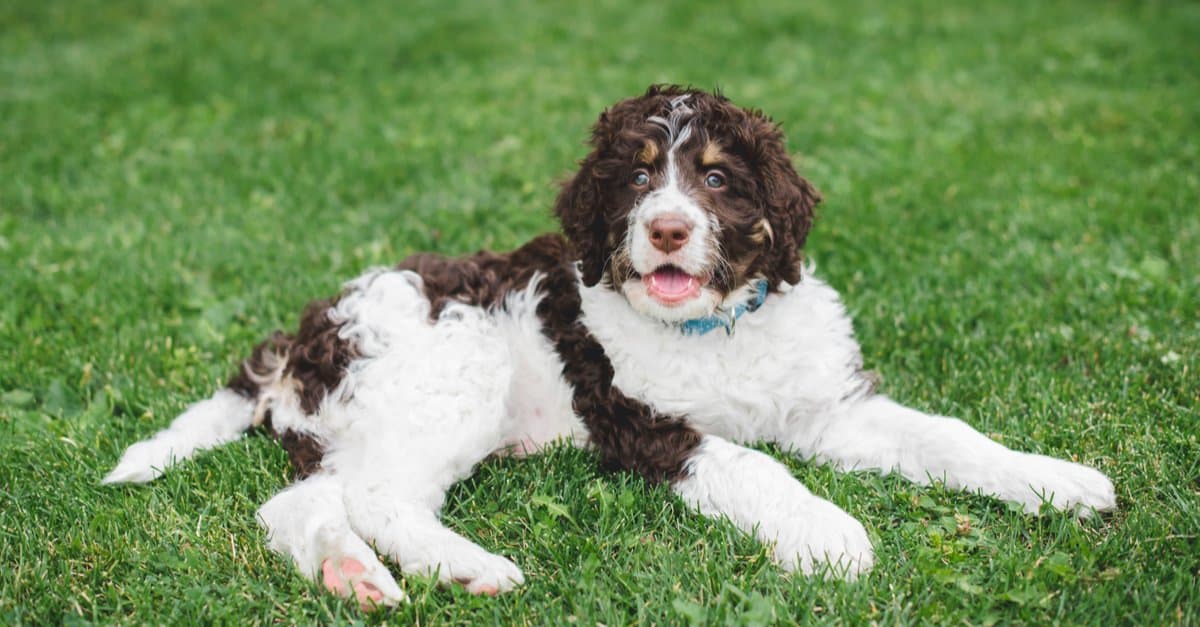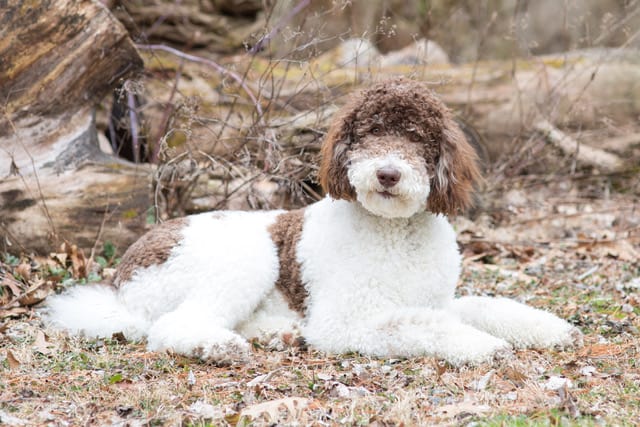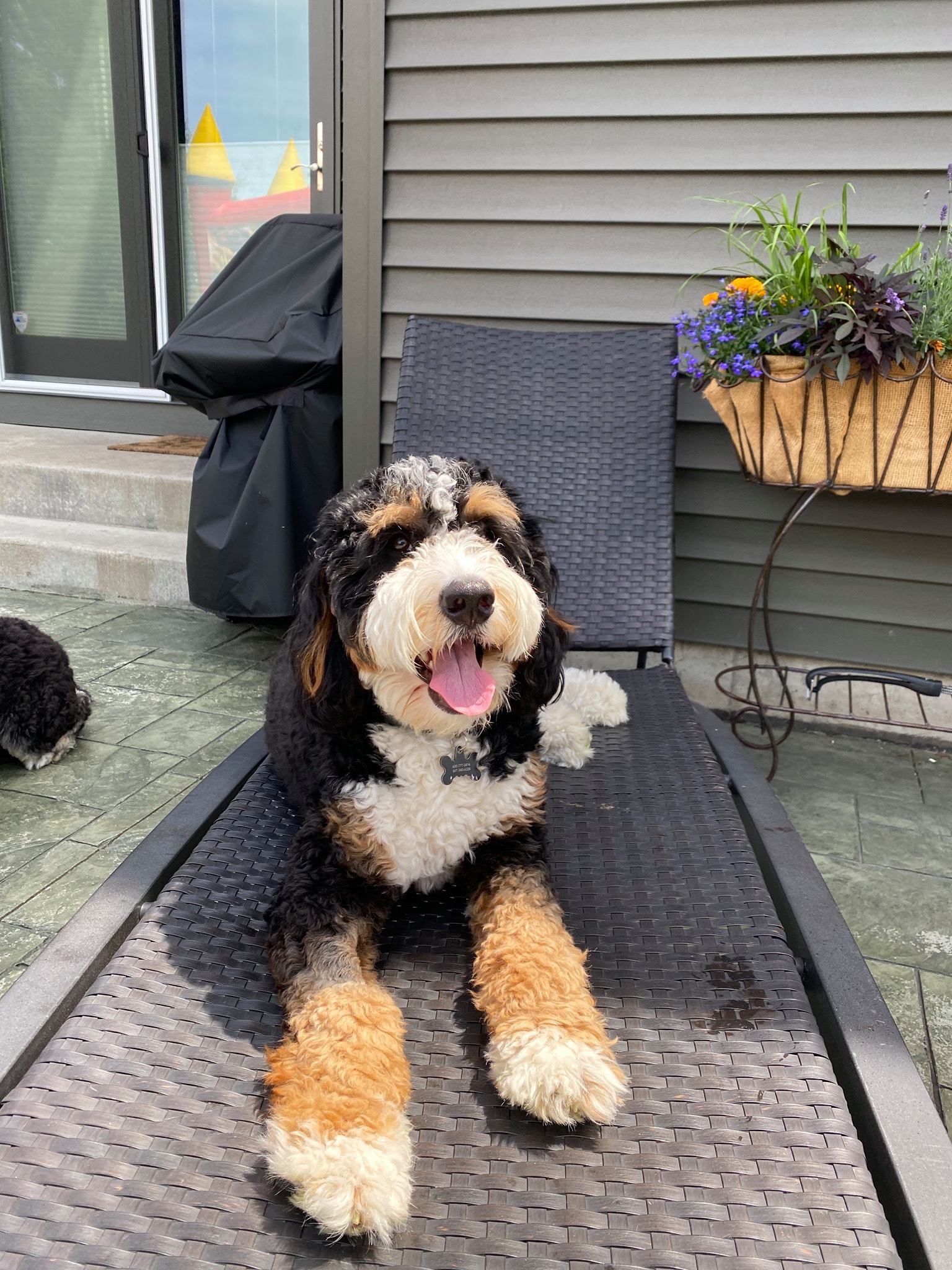Bernedoodles, with their adorable appearance and friendly demeanor, have quickly become a popular choice for dog lovers. However, with their unique coat, grooming becomes an important aspect of their care routine. In this comprehensive guide, we’ll delve into the details of how often Bernedoodles need to be groomed to keep them looking and feeling their best.
Understanding Bernedoodle Coats

1. Curly Coat
- Resembles Poodle: Bernedoodles with curly coats inherit this trait from their Poodle parent. Their curly hair is often hypoallergenic, making them a popular choice for allergy sufferers.
- Maintenance: Curly coats require frequent grooming to prevent matting and tangling. Without regular brushing, mats can form close to the skin, leading to discomfort and potential skin issues.
- Grooming Tools: Slicker brushes or metal combs are ideal for curly coats, as they effectively detangle and remove loose hair. Regular grooming sessions are essential to keep the curls manageable and prevent mats from forming.
2. Wavy Coat
- Combination of Straight and Curly: Wavy coats feature a combination of straight and curly hair, resulting in a wavy appearance. This coat type offers a balance between the hypoallergenic properties of Poodle coats and the softness of Bernese Mountain Dog coats.
- Maintenance: While wavy coats may require less grooming compared to curly coats, they still benefit from regular brushing to prevent tangling and maintain a sleek appearance. Occasional trimming may be necessary to manage longer hair around the ears and feet.
- Grooming Tools: A combination of slicker brushes and pin brushes can effectively groom wavy coats. These brushes help detangle knots and distribute natural oils throughout the coat, promoting shine and health.
3. Straight Coat
- Resembles Bernese Mountain Dog: Bernedoodles with straight coats typically inherit this trait from their Bernese Mountain Dog parent. Their straight, silky hair may shed more than curly or wavy coats but still requires regular grooming.
- Maintenance: Straight coats may be easier to maintain compared to curly or wavy coats, but they still benefit from regular brushing to remove loose hair and prevent matting. Trimming around the ears, feet, and tail may be necessary to maintain a neat appearance.
- Grooming Tools: A slicker brush or a combination of slicker brush and shedding rake can effectively groom straight coats. These tools help remove loose hair and distribute natural oils, keeping the coat healthy and shiny.
Factors Influencing Grooming Frequency

1. Coat Type:
- Curly Coats: Bernedoodles with curly coats often require more frequent grooming due to the nature of their hair. Curly hair is prone to tangling and matting, especially if left unattended. As a result, owners of curly-coated Bernedoodles may need to groom their dogs more often to prevent mats and keep the coat in good condition.
- Wavy Coats: Wavy-coated Bernedoodles fall somewhere in between curly and straight coats in terms of grooming needs. While wavy coats may not mat as easily as curly coats, they still require regular attention to prevent tangles and maintain a sleek appearance.
- Straight Coats: Bernedoodles with straight coats may require less frequent grooming compared to curly or wavy coats. However, regular brushing is still necessary to remove loose hair and prevent matting, especially during shedding seasons.
2. Activity Level:
Active Dogs: Bernedoodles that lead an active lifestyle, such as those who enjoy outdoor adventures or participate in activities like hiking or swimming, may require more frequent grooming. Increased activity can lead to a buildup of dirt, debris, and outdoor elements in the coat, necessitating more frequent grooming sessions to keep the coat clean and healthy.
3. Environment:
Climate and Weather Conditions: The climate and weather conditions in which a Bernedoodle lives can also influence grooming frequency. For example, Bernedoodles living in humid or rainy climates may be more prone to matting and coat issues due to increased moisture levels. In contrast, Bernedoodles in dry or arid climates may experience less frequent coat-related issues but may still require regular grooming to remove dirt and debris.
4. Personal Preferences:
Owner Preferences: The grooming frequency of a Bernedoodle may also be influenced by the personal preferences of the dog’s owner. Some owners may prefer to keep their dog’s coat shorter for easier maintenance, while others may opt for longer, more natural-looking coats. These preferences can impact how often grooming sessions are scheduled and the level of maintenance required for the coat.
5. Coat Health and Condition:
Overall Coat Health: The health and condition of a Bernedoodle’s coat can also impact grooming frequency. Dogs with healthy, well-maintained coats may require less frequent grooming compared to dogs with coat-related issues such as matting, dryness, or skin conditions. Regular grooming can help maintain coat health and prevent potential issues from arising.
Recommended Grooming Schedule

1. Brushing:
Daily: Brushing your Bernedoodle’s coat daily is highly recommended, regardless of the coat type. Daily brushing helps prevent matting, removes loose hair and debris, and distributes natural oils throughout the coat for a healthy shine. It also provides an opportunity to check for any skin issues or abnormalities.
Tools: Use a slicker brush, pin brush, or comb appropriate for your Bernedoodle’s coat type to effectively remove tangles and mats. Pay special attention to areas prone to matting, such as behind the ears, under the legs, and around the tail.
2. Bathing:
Every 4-6 Weeks: Bathe your Bernedoodle every 4 to 6 weeks, or as needed, using a mild dog shampoo formulated for their coat type. Over-bathing can strip the coat of natural oils, leading to dryness and irritation, so aim for a balance between cleanliness and coat health.
Technique: Thoroughly wet your Bernedoodle’s coat, apply shampoo, lather gently, and rinse thoroughly to remove all soap residue. Be sure to dry your dog completely to prevent skin issues.
3. Professional Grooming
Every 6-12 Weeks: Schedule professional grooming sessions every 6 to 12 weeks, depending on your Bernedoodle’s coat type and grooming needs. Professional groomers can trim, shape, and style your dog’s coat, as well as provide additional services such as nail trimming and ear cleaning.
Benefits: Professional grooming helps maintain coat health, prevents matting, and ensures your Bernedoodle looks their best. It also provides an opportunity for thorough grooming by experienced professionals.
4. Nail Trimming

Every 4-6 Weeks: Trim your Bernedoodle’s nails every 4 to 6 weeks to prevent overgrowth, discomfort, and potential issues such as ingrown nails. Regular nail trimming is essential for maintaining your dog’s mobility and paw health.
Technique: Use sharp, high-quality nail clippers designed for dogs and trim carefully, avoiding the quick (the blood vessel inside the nail). If you’re unsure, consult a veterinarian or professional groomer for guidance.
5. Ear Cleaning
Every 1-2 Months: Clean your Bernedoodle’s ears every 1 to 2 months to remove wax, debris, and prevent ear infections. Regular ear cleaning helps maintain ear health and prevents issues such as ear infections.
Caution: Use a veterinarian-approved ear cleaning solution and avoid inserting anything into the ear canal. Gently wipe the outer ear with a cotton ball or pad to remove dirt and wax buildup.
6. Teeth Brushing
Daily or Weekly: Brush your Bernedoodle’s teeth daily or weekly to prevent tartar buildup, plaque, and maintain oral health. Regular teeth brushing helps prevent dental issues and keeps your dog’s breath fresh.
Products: Use a dog-friendly toothbrush and toothpaste, or dental chews and toys, to supplement dental care. Aim for consistency to establish good oral hygiene habits.
Additional Tips for Grooming Success

1. Start Early
Introduce grooming routines from a young age: Begin grooming your Bernedoodle puppy as early as possible to acclimate them to the process. Early exposure helps puppies become comfortable with grooming tasks and reduces anxiety during future sessions.
2. Use Proper Tools
Invest in high-quality grooming tools: Choose brushes, combs, nail clippers, and other grooming equipment specifically designed for your Bernedoodle’s coat type. High-quality tools are more effective and safer for your dog’s grooming needs.
3. Be Patient and Gentle
Approach grooming sessions with patience and gentleness: Take your time and be gentle when grooming your Bernedoodle, especially if they’re sensitive or nervous. Use soothing words, treats, and positive reinforcement to create a calm and enjoyable grooming experience.
4. Reward Good Behavior
Reinforce positive behavior with rewards: Reward your Bernedoodle with treats, praise, and affection during grooming sessions to reinforce good behavior. Positive reinforcement encourages cooperation and makes grooming a pleasant activity for your dog.
5. Regular Maintenance

Stay consistent with your grooming routine: Maintain a regular grooming schedule to prevent matting, tangling, and other coat-related issues. Consistent grooming ensures that your Bernedoodle’s coat remains healthy, manageable, and visually appealing.
6. Monitor Coat Health
Regularly assess your Bernedoodle’s coat health: Keep an eye out for signs of skin issues, matting, or abnormalities during grooming sessions. Address any concerns promptly by consulting a veterinarian or professional groomer for advice.
7. Consider Professional Help
Seek professional grooming assistance when needed: If you’re unsure about grooming techniques or encounter challenges with your Bernedoodle’s coat, don’t hesitate to seek help from a professional groomer. Professional groomers have the expertise and experience to address specific grooming needs and provide guidance.
8. Be Flexible
Adapt your grooming approach as needed: Every Bernedoodle is unique, so be flexible and adjust your grooming techniques based on your dog’s individual preferences and sensitivities. Experiment with different tools, methods, and grooming products to find what works best for your furry friend.
Conclusion
Grooming plays a crucial role in maintaining the health and appearance of Bernedoodles. By understanding their coat type, considering various factors, and following a recommended grooming schedule, you can keep your Bernedoodle looking their best and ensure their overall wellbeing. With regular grooming and proper care, your Bernedoodle will continue to be a happy and healthy companion for years to come.

